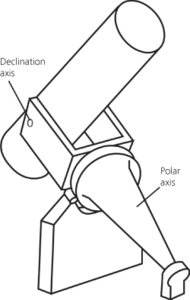A type of equatorial mounting consisting of an open-ended two-pronged fork, which forms the polar axis, with the telescope pivoted between the prongs of the fork on a declination axis. The design provides access to all parts of the sky and does not need a counterbalance, but is unsuitable for refractors or long-focus reflectors as the forks would need to be very long. A version of the fork mounting is often used on Schmidt–Cassegrain telescopes.

- mesh analysis
- mesh contour
- mesh current
- MESH equations
- mesh interconnection
- mesh loop
- mesh voltage
- mesic
- Mesoarchaean
- mesocarp
- mesoclimate
- mesocratic
- mesocyclone
- mesoderm
- mesofauna
- Bruno, St (c.1032–1101)
- Brunschvicg, Léon (1869–1944)
- brush
- brush border
- brush discharge
- brushing
- Brusilov, Aleksky (1853–1926)
- brusselator
- brute fact
- brute force